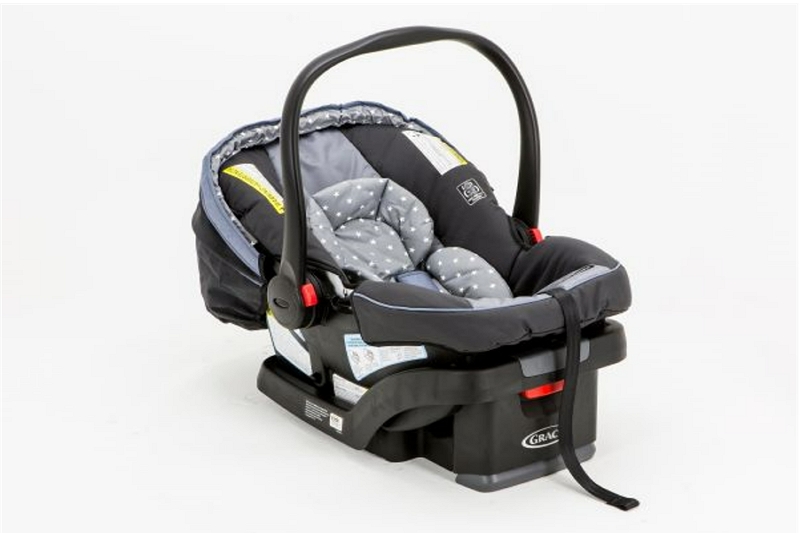When do you transition out of infant car seat? When the baby becomes too big. Generally, babies are around nine months old when they graduate to a convertible carseat or forward-facing harnessed booster.
It’s important for your child’s safety that you use an appropriate child restraint at each stage of life.

This means using the rear-facing restraints until they can sit up unassisted and front-facing restraints once their neck muscles have developed sufficiently to protect them in case of collision, usually by age two years old.
Your paediatrician will likely recommend transitioning into either a combination restraining system (harness with internal belt), depending on how much your child weighs, or if he is well over 40 pounds then it is time for just using a lap and shoulder belt.
On a side note, when you do transition out of an infant car seat and into either the combination restraining system or just using a lap and shoulder restraint, it’s important to remember that your child is still too young for proper use of his/her safety belts.
This means they should be placed in the backseat until he/she is at least four years old. Each year after that reduces their risk of fatal injury by up to fifty per cent, so try not to move them forward before then if possible (and safe).
When can I flip my toddler’s car seat?
When your toddler’s neck is higher than the seat of their car seat, it’s time to turn them around. In most cases, children should be in a five-point harness until at least age foursome go up to age six or eight!
How many pounds is a convertible car seat?
A rear-facing infant car seat typically supports infants up to about 30lbs and babies around 20 inches tall, but some can hold kids weighing as much as 35lb with a height limit of 32in before switching them into front-facing toddler safety seats which typically support children between 22 and 65lbs depending on the model.
It’s important to remember though, parents should never place an infant carrier in the front seat because it could put their baby at risk during airbag deployment.
Is a booster seat easy to install?
All car seats, but especially those that are used with harnesses need to be installed correctly. There should not be more than one inch of movement at the belt path and the chest clip needs to line up at the armpit level for proper protection in case of an accident.
The lap portion should also fit low on your child’s hips without riding too high on their stomachs where it could cause injury during impact.
If you can’t get both sides tight enough then try moving them forward or back slightly until they do so this will ensure the safest installation possible even if it means adjusting your rearview mirror accordingly because children’s lives are worth far more than any inconvenience caused by having to reposition your mirror.
Can a 7-year-old use a backless booster seat?
Yes, if their child is 40 or fewer lbs. and over 38 inches tall. If not, they should be in a harnessed car seat until they are at least 100lbs. This can help protect your children as much as possible from serious injury during an accident.
How long should a child be in a high back booster?
A child should be in a high back booster until they meet the height and weight requirements for their seat belt system. This can vary depending on your state’s laws, so you’ll need to check with your local DMV or law enforcement agency to find out what those requirements are where you live.
Generally speaking, however: For children under 40 pounds and under 40 inches tall (most kids this age will not have reached puberty), it is recommended that parents use a high-back booster without any additional padding underneath them.
Children over 80 pounds but less than 100 pounds may benefit from using an adjustable low-back booster, which allows younger children to sit more upright while still giving them the necessary protection of a five-point harness.
However, these boosters also require children to be able to pull the shoulder belt down on themselves and buckle up without help. For larger children who can do this, a high-back booster with additional padding is recommended.
Do high-back boosters need to be tethered?
No, high-back boosters do not need to be tethered. The tether strap is an extra safety measure that can only help, but it should never replace proper seat belt positioning in a booster.
Many state laws require the use of a vehicle’s lap and shoulder belts when using a high back booster as opposed to just lap belts as with lower backless models or no belt at all if you are still using a shield type carseat.
This means you will have two sets of straps – one across your child’s chest and another between their legs – which does take some getting used to after years without this second set for smaller children who may still fit better in harnessed seats than they do boosters.
Restraint systems used in high back boosters are less complex than those of harnessed car seats, which means they do not need to be tethered.
